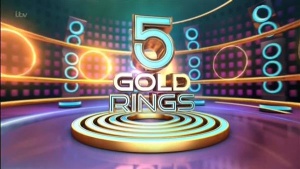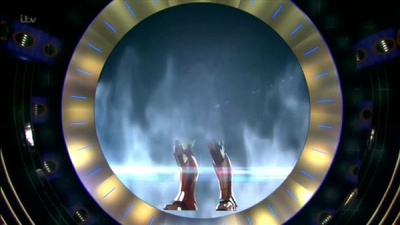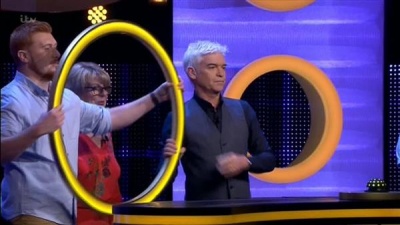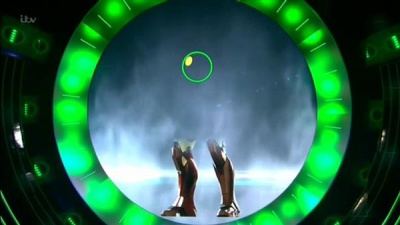5 Gold Rings
Synopsis
The ITV press office summed up the show:
- The contestants answer questions by placing gold rings onto a supersized image displayed beneath their feet on a huge circular LED floor. When a question is asked, the players put a gold ring on the floor where they think the answer lies. If they get it wrong they lose a ring, but if they get it right they move up to the next level. Each level is worth more money, but the ring gets smaller each time. The team that performs best takes control of the final, there can be only one winner.
The game is very simple to play. Here is a picture of Iron Man from the movies. All we're going to show is the character's legs up to the knees. Where is the power pack on his chest?
One player goes on to the floor, to put a large ring onto the picture. Their playing partner stands on the sidelines, shouting directions. After 30 seconds, we find out if any part of the answer is inside the ring.
Get the answer right, and the team banks money, and moves on to the next question. "As the money goes up, the rings get smaller," says Schofe. It's almost a catchphrase, perhaps a little too clunky. The first question is for £1000, then for £2500, £5000, £10,000 and a top prize of £25,000.
Get it wrong, a hole appears, and the other player goes in to move the ring. Teams stop playing if they make five errors (lose all five gold rings), or get the £25,000 answer correct.
There are two lifelines. "Flip the board" replaces the current question with another one of similar difficulty. "Ask the panel" gives the answers from five friends-and-family in the studio audience.
The final is one question: either a test of memory, or a prediction. The team with more money chooses whether to play with a big ring, or pass to their opponents with a smaller ring. Get the final question right to win your money: get it wrong and the other side wins their money.
It's not a perfect show: the first team completes its game before the second team starts its journey, so we don't meet two of the players for ages, and the middle part feels like we're going over old ground again.
But there are many things right. Someone must win each show. Viewers can play along on mobile phone apps, and will play along by shouting at the telly. We're also impressed by the range of questions: not just maps and diagrams, but observation, memory, and wider knowledge.
A number of changes were made for the second and subsequent series, of which we heartily approve. Teams now take it in turns to play, as opposed to waiting for their opponents' game to end. Incorrect answers saw their opponents attempt their questions, meaning that - in having a guaranteed number of questions - play was brisker. In addition, question values became £1000, £2500, £5000, £7500 and £10,000 and accumulated, so the jackpot was more than doubled, from £25,000 to £52,000.
Inventor
Format created by Glenn Hugill and John de Mol.
Title music
Music composed by John Ewbank and by Sitting Duck Music & Media
Trivia
Where was Iron Man's powerpack?
An episode transmitted on 1 September 2019, billed as a celebrity special, contained Jimmy Carr and Rachel Riley each helping a member of the public, each of whom had brought in their own friends and family; making a total of two celebrities out of fourteen participants.





